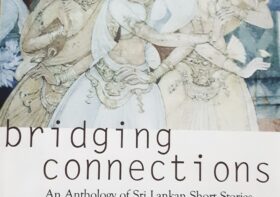Dr.G V Krishnarao’s Keelubommalu

Article by: GRK Murthy
Dr. GV Krishnarao, a Telugu poet, playwright, novelist, critic and the translator of Nagarjuna’s Vigrahavyavarthamu into Telugu, wrote Keelubommalu (Spring-dolls), his maiden novel, in 1951. At the beginning of the novel, Krishnarao makes it abundantly clear that the novel is primarily concerned about ‘Dharma’—how the fact of individual man giving a go-by to dharma leads to its fading from the society as a whole, and how this ultimately leads to human catastrophe. This reflects well in the invocation with which he starts his novel: “… luptamulayye dharmamulu, luptamulayye nudaravartanal / luptamulayye snehamulu, luptamulayye kalarasajnatal / luptamulayye bhavamulu, luptamulayye vicharadharalun / saptamu saptamimka manasa! Digulondaku matrubhumikai”— “Virtue, generosity, friendship, appreciation for art, incredible stream of ideas, are all waning; a curse is looming large; O heart! Weep not for the motherland.”
Indeed Krishnarao pours out his agony at the current state of affairs in the villages by making Dr Vasudevasastri, one of the characters in the novel, perhaps, the alter ego of the author, reflect thus:
“The very struggle that is going on today in our society is … questioning the very essence of shruthi and smrithi… man is anxious to create a new order… Whatever is good for the majority that alone is the dharma. They say whatever is useful that alone is the sastra and whatever delights them that alone is the kala, art… With these ideas they are driving people crazy. Forgetting the fact of ‘being endowed with wisdom that one can decide on one’s own’, people are simply joining this mad frenzy. Under these circumstances, the minority like us is left with only two alternatives. Casting off our individuality, we must join the majority lot… Or, overcoming narrow self-interest, we should be able to show worth practicing dharmamarg—a path that is virtuous and useful to whole of the mankind. And we must show that the suggested path is logically appropriate and adoptable by first practicing it in our own life… Today, the wise have such a great duty. If these two things do not happen, we will be annihilated” (p. 47).
Driven by this central idea, the author structures his novel with such incidents and characters narrating their struggle—amidst colossal weight of tradition, high bound casteism, and die-hard dogma of religious conformism, most of which is again controlled by the levers of the all pervading socio-political corrupt system that is fast taking roots in the villages—from a frame of Freudian psycho-analytical theories and Marxism in a language that well afforded him achieve the objective of ‘unity of effect’ in his letting the reader realize how failing of people to think independently and be guided by dharma in their conduct and instead, acting merely as dolls keyed-in by the circumstances is ruining the lives. Against this backdrop, let us examine as to how far the author succeeded in using Edgar Allan Poe’s ‘unity of effect’ theory to drive home his philosophy of individual dharma as the rudder for peaceful coexistence of mankind through his Keelubommalu.
The novel begins with Pullayya—one of the respectable farmers of the village who, for his daughter, Sita, was “an incarnation of dharma, as mercy personified, and thought that no one in the village was as intelligent as he”—letting a rumor do rounds in the village about Chandrasekharam forging his signature as surety for the loan of Rs. 5000 that he took for his paper mill from a Marwari that amounts to an implicit lie, which ultimately defines its own irreversible course that ruins the lives of people who come in its path.
Making use of the Freudian psycho-analytical theories, the author builds up convincing events that lead Pullayya to finally decline the fact of his standing as guarantor. It was not his losing of five thousand rupees by virtue of his standing as guarantor that caused him great consternation, but it was his fear of his wife that had terribly challenged his wit, for she was known to create ruckus about anything that he did against the family interests, that too, without her knowledge. The other most painful issue associated with the surety was about his reputation in the village, for he feared that once the villagers come to know that he had been fooled by Chandrasekaharam, his prestige will get bad drubbing.
As he was passing through this mental trauma, one night his daughter innocently asked him if he had stood surety for Chandrasekharam?” “Who told you so?” asked Pullayya rather casually. “Well … everyone”, replied she. In his drowsiness, he said, “People … what else they have to do?” (p. 6). Concluding from it that her father did not stand as guarantor, she shared it with the labor in the backyard. Thus the message spread across the village. Coming to know of it, Pullayya initially wanted to put a stop to it, for it would amount to breaking his word—a shameful thing, because of which he wondered if he could ever raise his head in the village. In the meanwhile, learning about it from her daughter, his wife, Lakshamamma, went to the lawyer and arranged for a notice to be issued to Chandrasekharam for his forging her husband’s signature.
Coming to know of this, Pullayya felt furious at her assuming the authority. As she returned, he frowned at her with angry, burning eyes. But when she replied that she she had as much right as he had in the matters of money of the family, he haplessly stamped out of the house. Here the author traces his existential dilemmas thus: “Realized that he himself was responsible for all this mess—had he clearly explained things to Sita, such false news would not have spread; his wife would not have gone to the lawyer. Now, if the notice is served it would shock the whole village. His reputation would then be at stake. What if, if he could go to Seshagiri [lawyer] right now? He might have not yet sent the notice. He might as well explain things to him! Is he to give explanation to that kid? What if, if he had already sent the notice? He must then say it was all wrong. Then his wife will become a laughing stock in the village. If people laughed at him or his wife—is there any difference? Would it be better to go to Chandrasekharam, explain the mistake and plead with him? It wouldn’t do either. Having helped him in the hour of need, is he now to kneel before him? … Could see no way to come out of the mess? …” (p. 11).
On the other side, the author sculpted Chandrasekharam as a man hailing from a rich background. He would have gone on without any vicissitudes, if he had, like others, looked after his lands carefully. But, during his college days he had been attracted to a political ideology which stated: “Human welfare depends on an equitable distribution of wealth. It is the misapplication of principles of wealth distribution that led to binaries such as the rich and the poor… So dharma is getting eroded and life is becoming unbearable … Once the principles of a fair distribution of wealth are applied, society will sparkle” (p. 12). Driven by this philosophy, he converted his landed assets into cash and along with additional borrowings built a paper mill. It ran alright for sometime. Later owing to his lack of managerial skills and workers’ demands for additional facilities, the mill had closed. He lost everything. He ended up in heavy debts. Many farmers who gave him loans had lost heavily. Darkness encircled him. In this morbid guilt and also fearing creditors, he could go home in the nights only.
On one such late night, as he was coming home, he was told by fellow villagers that everyone in the village was talking about his forging Pullayya’s signature as surety and borrowing money from the Marwari. He was surprised by it. He was also told that he would soon receive a legal notice. His stock reply was, “All right, the truth will emerge then.” As he left for home, he wondered if his wife knew about it. How she would react to the news? Ruminating on it, he somehow reassured himself. Unlike his earlier misfortunes, he was conscious that this one was not his making. He thought that he could prove his innocence of this misfortune to her and also the ruthlessness of the world. He felt a newfound strength in that thought. Indeed, after reaching home that is what he exactly did when his wife had shown him the notice of Pullayya, and felt reassured. A whimsical relief!
Though notice was issued to Chandrasekharam, Pullayya’s subconscious mind continued to trouble him constantly, for “He never wanted to get into such a mess. Nor does he ever wanted to do something so wrong. There was no enmity between him and Chandrasekharam. He felt that sending a man like him to jail was horrible in itself. He too had children. Wouldn’t his sending Chandrasekharam to jail affect his own family? Finally, he blamed circumstances for his present plight. Wondered, how was he to get out of this dreadful mess?” (p. 20). Owing to its constant pricking, he lost his appetite. Lost sleep too.
Driven by intense guilt, at times Pullayya behaved crazily. For instance, one day, as his widowed daughter-in-law, squatting on the floor, wailed at god for having given her a son who could lie at that young age itself, Pullayya, deeply shaken by the scene, perceiving himself as the cause of her sorrow… in a trance-like oblivion, abruptly walking up to her blurted, “Amma, don’t weep… The whole blame is mine. I won’t do it again. I swear it on your feet.”And all at once, he prostrated before her (p. 38). Such was the internal turmoil that Pullayya was subjected to by the turn that the surety issue took.
As Pullayya was thus suffering, others like Ammayamma, a social worker from the village and Mallayya, the richest money lender of the village, and the opponent of Pullayya in the village were scheming how to capitalize on this new development for enhancing their own status in the village. In the process, Mallayya having come to know that Pullayya did sign as surety, started scheming how to undercut Pullayya from behind by fanning the sectarian politics of the village to play its own role in making things difficult for Pullayya to manage in his favor.
The other important character in the novel was Vasudevasastry, a strange man born into an orthodox Brahmin family. He was a freedom fighter. He studied MBBS. He came back to the village and practiced medicine. His wife had died. Despite his father insisting him to marry again, he preferred to remain unmarried. Money was never an important thing for him. He was serving the poor with equal concern demanding no money, with whatever little he collected from the well-to-do farmers. The author sculpts him as the sole character in the novel who had concern for dharma and its practice. Indeed, the author avails Sastry here and there to air his perceptions about life in general and dharma in particular. For instance, as he came to know that Pullayya and Chandrasekharam were taking the surety matter to the Court and in the process were trying to enlist witnesses in their support, and fearing that it would inflame rancor in the village, Sastry thus reflected: “The cawing of a crow in trouble gets ten sympathetic crows. Human beings are different… Why didn’t people have the amity that birds and animals had? Why were there such bitter quarrels and hostility? Why were cooperation, tolerance, sympathy and harmony on the wane? Without them, can humanity exist? Well! Why should he be bothered about these things? … Why this analysis of dharma and adharma? Didn’t everyone have the ability to think for himself? Was he in any way superior to them? Wasn’t it egotistical of him to think of managing other peoples’ problems? He should do only what his conscience dictated and follow what he thought was right. That is the only way to move on” (p. 48). That is how the author… perhaps… expects the people to conduct themselves too.
Fiction




తృష్ణ
పాత్రల చిత్రణ పరంగా గొప్ప నవల అని విని, కొని రెండు నెలలవుతోందండి.. చదవాలని ఉత్సాహం వచ్చింది మీ వ్యాసం చదివాకా!